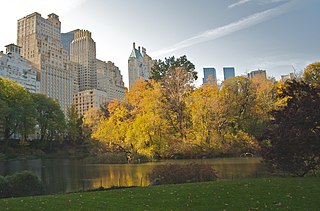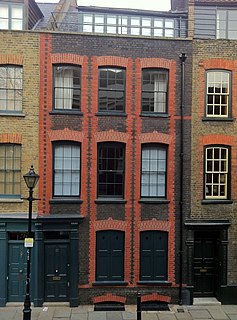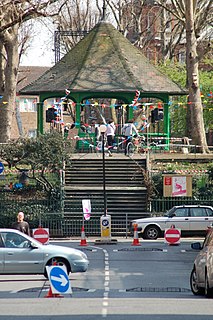
Stamford Hill is an area in Inner London, England, located about 5.5 miles north-east of Charing Cross. The neighbourhood is a sub-district of Hackney, the major component of the London Borough of Hackney, and is known for its Hasidic community, the largest concentration of Hasidic Jews in Europe.

Stepney is a district in the East End of London in the London Borough of Tower Hamlets. The district is not officially defined, and is usually used to refer to a relatively small area, however for much its history the place name applied to a much larger manor and parish.

An apartment, or flat, is a self-contained housing unit that occupies only part of a building, generally on a single storey. There are many names for these overall buildings, see below. The housing tenure of apartments also varies considerably, from large-scale public housing, to owner occupancy within what is legally a condominium, to tenants renting from a private landlord.

Spitalfields is a district in the East End of London and within the London Borough of Tower Hamlets. The area is formed around Commercial Street and includes the locale around Brick Lane, Christ Church, Toynbee Hall and Commercial Tavern. It has several markets, including Spitalfields Market, the historic Old Spitalfields Market, Brick Lane Market and Petticoat Lane Market. It was part of the ancient parish of Stepney in the county of Middlesex and was split off as a separate parish in 1729. Just outside the City of London, the parish became part of the Metropolitan Board of Works area in 1855 as part of the Whitechapel District. It formed part of the County of London from 1889 and was part of the Metropolitan Borough of Stepney from 1900. It was abolished as a civil parish in 1921.

A tenement is a type of building shared by multiple dwellings, typically with flats or apartments on each floor and with shared entrance stairway access. These are common in Scotland. In the medieval Old Town, Edinburgh, tenements were developed with each apartment treated as a separate house, built on top of each other. Over hundreds of years, custom grew to become law concerning maintenance and repairs, as first formally discussed in Stair's 1681 writings on Scots property law. In Scotland, these are now governed by the Tenements (Scotland) Act 2004, which replaced the old law of the tenement and created a new system of common ownership and procedures concerning repairs and maintenance of tenements. Tenements with one or two room flats provided popular rented accommodation for workers, but in some inner-city areas, overcrowding and maintenance problems led to slums, which have been cleared and redeveloped. In more affluent areas, tenement flats form spacious privately owned houses, some with up to six bedrooms, which continue to be desirable properties.

Nathaniel Mayer Rothschild, 1st Baron Rothschild, Baron de Rothschild, was a British Jewish banker and politician from the wealthy international Rothschild family.

The Peabody Trust was founded in 1862 as the Peabody Donation Fund and now brands itself simply as Peabody. It is one of London's oldest and largest housing associations with around 55,000 properties across London and the South East. It is also a community benefit society and urban regeneration agency, a developer with a focus on regeneration, and a provider of an extensive range of community programmes.

Fournier Street, formerly Church Street, is a street of 18th-century houses in Spitalfields in the East End of London. It is in the London Borough of Tower Hamlets and runs between Commercial Street and Brick Lane. The street is named after a man of Huguenot extraction, George Fournier.
Multi-family residential is a classification of housing where multiple separate housing units for residential inhabitants are contained within one building or several buildings within one complex. Units can be next to each other, or stacked on top of each other. A common form is an apartment building. Many intentional communities incorporate multifamily residences, such as in cohousing projects.

The Boundary Estate is a housing development in Shoreditch, formally opened in 1900, in the East End and in East London, England. It is situated in the London Borough of Tower Hamlets.

Flower and Dean Street was a road at the heart of the Spitalfields rookery in the East End of London. It was one of the most notorious slums of the Victorian era, being described in 1883 as "perhaps the foulest and most dangerous street in the whole metropolis", and was closely associated with the victims of Jack the Ripper.

The East End of London, often referred to within the London area simply as the East End, is the historic core of wider East London, east of the Roman and medieval walls of the City of London and north of the River Thames. It does not have universally accepted boundaries to the north and east, though the River Lea is sometimes seen as the eastern boundary. Parts of it may be regarded as lying within Central London. The term "East of Aldgate Pump" is sometimes used as a synonym for the area.

Columbia Road Flower Market is a street market in Bethnal Green in London, England. Columbia Road is a road of Victorian shops off Hackney Road in the London Borough of Tower Hamlets. The market is open on Sundays only.
Model dwellings companies (MDCs) were a group of private companies in Victorian Britain that sought to improve the housing conditions of the working classes by building new homes for them, at the same time receiving a competitive rate of return on any investment. The principle of philanthropic intention with capitalist return was given the label "five per cent philanthropy".
The Improved Industrial Dwellings Company (IIDC) was a Victorian Model dwellings company founded in 1863 by the printer, philanthropist and later Lord Mayor of London Sir Sydney Waterlow. The company operated predominantly in Central London as a provider of block dwellings for the working classes, employing a strict selection and discipline regime amongst its tenants to ensure a healthy return on investment. Starting with a capital of £50,000, the IIDC became one of the largest and most successful of the model dwellings companies, housing at its height around 30,000 individuals.
The Metropolitan Association for Improving the Dwellings of the Industrious Classes (MAIDIC) was a Victorian-era, philanthropically-motivated Model Dwellings Company, a fore-runner of the modern housing association which sought to provide affordable housing for the working classes on a privately run basis, with a financial return for investors. Although not the first society to build such homes, the Association was the first to be founded expressly for this purpose. As such it was one of the earliest adopters of the principal of the five per cent philanthropy model, outlined in the Company's resolution: "that an association be formed for the purpose of providing the labouring man with an increase of the comforts and conveniences of life, with full return to the capitalist."
The East End Dwellings Company was a Victorian philanthropic model dwellings company, operating in the East End of London in the latter part of the nineteenth century. The company was founded in principle in 1882 by, among others, Samuel Augustus Barnett, vicar of St Jude's Church, Whitechapel; it was finally incorporated in 1884.
Jerry White is a British historian who has specialised in the history of London. From 1997 onwards he has worked on a trilogy of books about London from 1700 to 2000.

Prince Albert’s Model Cottage was the name given to a model dwelling designed in the mid-19th century to offer an alternative form of accommodation for poor families in England. It was supported by Prince Albert, husband of Queen Victoria.













